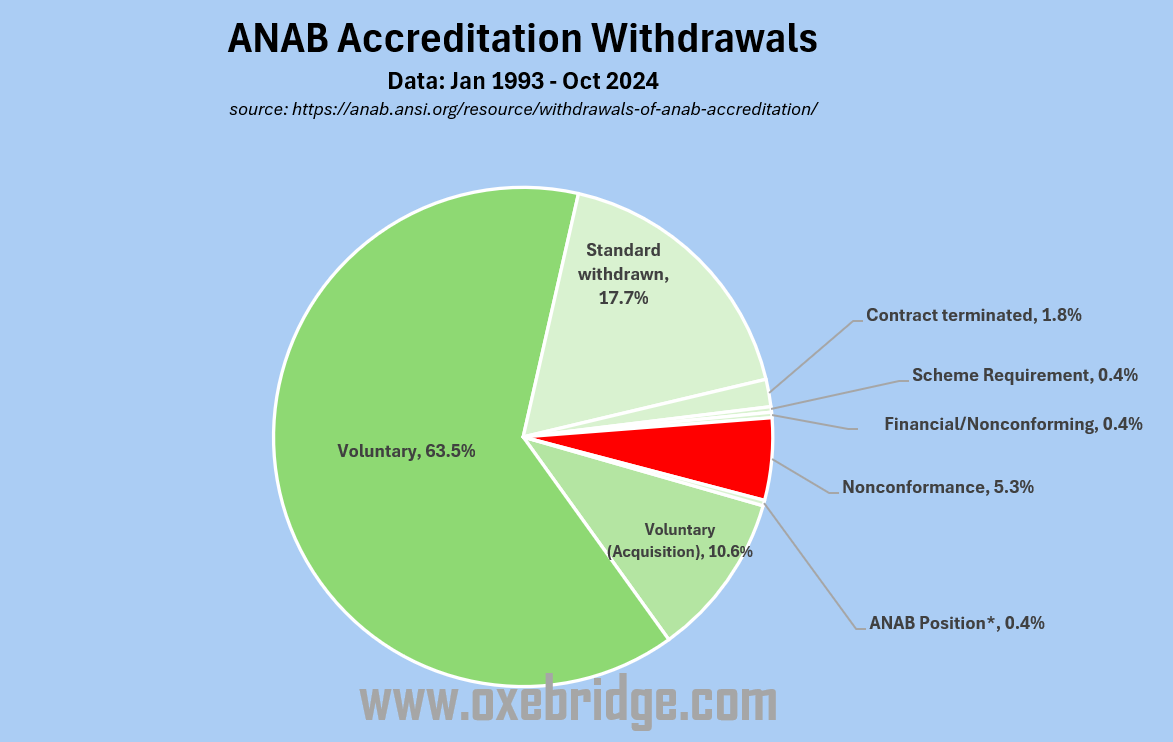The US accreditation body ANAB has one job: to ensure that accredited certification bodies using its logo comply with the applicable accreditation standards. So, a CB wanting to issue ISO 9001 certificates while being ANAB accredited must comply with ISO 17021-1, and ANAB’s job is to audit them to ensure that it does. Then, if the CB does not comply, ANAB must withdraw that accreditation. This is to stop fraudsters from issuing ISO certificates, which corrupt companies use to gain access to crucial manufacturing and service contracts.
You know, like building airplanes and cars and implantable pacemakers. Important stuff.
Despite uninformed folks saying otherwise, the entire ISO certification scheme was specifically created to fight fraud. CBs and their apologists love to say that auditors are not there to identify fraud, but that is precisely why CB audits exist. The scheme was to stop companies from saying they comply with MIL specs and standards when they actually didn’t. Third-party conformity assessment is supposed to identify scammers and deny them access to contracts. If someone says something other than that, they are lying and don’t know their history.
ABs like ANAB are supposed to ensure that scammer CBs don’t operate, either. So how is ANAB doing?
Pay to Play
Using its own data — published right here ANAB’s own damned website — we can see the answer is “not so well.”
The chart below captures ANAB’s published data going all the way back to March of 1993 — as in over three decades ago — and shows that the overwhelming reason for withdrawal of accreditation is not anything to do with violations of ISO 17021-1 or related standards, but where CBs “voluntarily” drop their ANAB accreditation. Meaning, the only real way to lose ANAB accreditation once you pay for it is to give it up yourself.
Not exactly the kind of metric that instills confidence in a fight against fraud, is it?

All the green slices are one form of voluntary withdrawal or another, meaning not due to any actual findings or work by ANAB itself. These include where the CB just dropped ANAB accreditation, perhaps to switch to another AB (“voluntary“), where the CB merged with another (“voluntary – acquisition“), where an entire standard was withdrawn, making accreditation moot (“standard withdrawn“), and a few other industry-related reasons. The “ANAB position” one reflects the single CB from Russia that was thrown out because ANAB would have been violating US sanctions if they hadn’t.
A long time ago, ANAB published this same data with some additional details, including when CBs were dropped due to “non-payment” of fees. I reported on that, which showed such nonpayment was the second most common reason for withdrawal (below “voluntary“), and that made ANAB look bad, so they started burying “nonpayment” into the “contract terminated” and other slices. ANAB makes a single exception: “Graybie” is still listed as not having paid their bill, in a spiteful attempt to shame the shit out of them, I guess.
The real takeaway is that only 5.3% of withdrawals (15 out of a total of 282) were due to actual nonconformities reported by ANAB. Again, that is over thirty years.
Worse, the majority of those occurred between 2002 and 2009. The last reported withdrawal by ANAB was from September of 2016, meaning ANAB has not withdrawn a single CB for nonconforming practices in eight full years.
I did the same study back in 2016, using ANAB’s data as published then, and 8% of withdrawals were due to nonconformities. That was already pretty pathetic, but I hadn’t imagined it would get worse. But — silly me — ANAB can always get worse.
Now factor in that ANAB’s accredited schemes are growing, and the number of CBs they accredit are higher than they were ten years ago. So the likelihood that all these actors are suddenly behaving themselves, leaving ANAB nothing to report, defies all logic. Instead, it is abundantly clear that ANAB simply stopped doing its job, and is now, effectively, an accreditation mill.
The India Influence
So what changed? I can answer that, too: IAS.
The International Accreditation Service, before 2016, was a blip on the map. It was an Indian-run AB managed by Chuck Ramani, but out of a US access in California. They had been involved in other sectors and decided to get more heavily involved in the ISO accreditation world. Ramani — who had a good head on his shoulders — retired and was replaced by Raj Nathan, who leaned into all the worst tendencies of Indian scammer culture to begin accrediting anyone who could pay, while hiring underpaid third-world assessors to perform its global assessments. IAS accreditation can cost less than half of ANAB’s, and since the IAF let them in the door, they share entirely equivalent international recognition and standing. I help set up CBs for ISO 17021 accreditation now, and even I can’t justify letting clients use ANAB; why pay twice as much for an equally lousy service?

ANSI’s Joe Bhatia (l) with his China counterpart
Within a few years, IAS was eating away at ANAB’s market, so ANAB’s own Indian scammer — ANSI President Saranjit “Joe” Bhatia — pivoted, and ANAB stopped de-listing CB clients entirely. You see, if ANAB started tossing out the clients it had, that just gave more for IAS to gobble up.
It also didn’t help that ANAB’s Randy Daugherty retired around that same time, leaving ANAB in the chaos it continues to suffer: eight or more VPs without a single executive leader over any of them to keep them in control.
So, no, ANAB is not a functioning accreditation body if it merely grants accreditation and never takes it away. And we have evidence of multiple ANAB clients engaged in all sorts of bad behavior, all with ANAB’s blessing. Instead, ANAB has embraced the IAF “protection racket” scheme where if you pay them, they will run to your side and protect you from whistleblower complaints and official filings, but if you don’t — well, IAF and ANAB will publicly shame you. And if you don’t pay your bill — like Graybie, apparently — they will humiliate you, as well.
This has got to be illegal. It is when the Mafia does it, so why not ANAB?
ANAB control falls under the US House Committee on Science, Space and Technology (SST), which applies oversight to ANSI, ANAB’s parent. However, the SST committee got sidetracked by fighting against science after Republicans took control of the House. So they are not paying attention at all and letting ANSI and ANAB continue to defraud millions by claiming their accreditation “ensures” quality and trust, when in fact, an ANAB accreditation certificate is about as valuable as a bar napkin with a hooker’s phone number scrawled on it in lipstick.
So, if your ISO 9001 certified, “quality assured” product kills you, you know why. ANAB gotta eat.
Christopher Paris is the founder and VP Operations of Oxebridge. He has over 35 years’ experience implementing ISO 9001 and AS9100 systems, and helps establish certification and accreditation bodies with the ISO 17000 series. He is a vocal advocate for the development and use of standards from the point of view of actual users. He is the writer and artist of THE AUDITOR comic strip, and is currently writing the DR. CUBA pulp novel series. Visit www.drcuba.world








